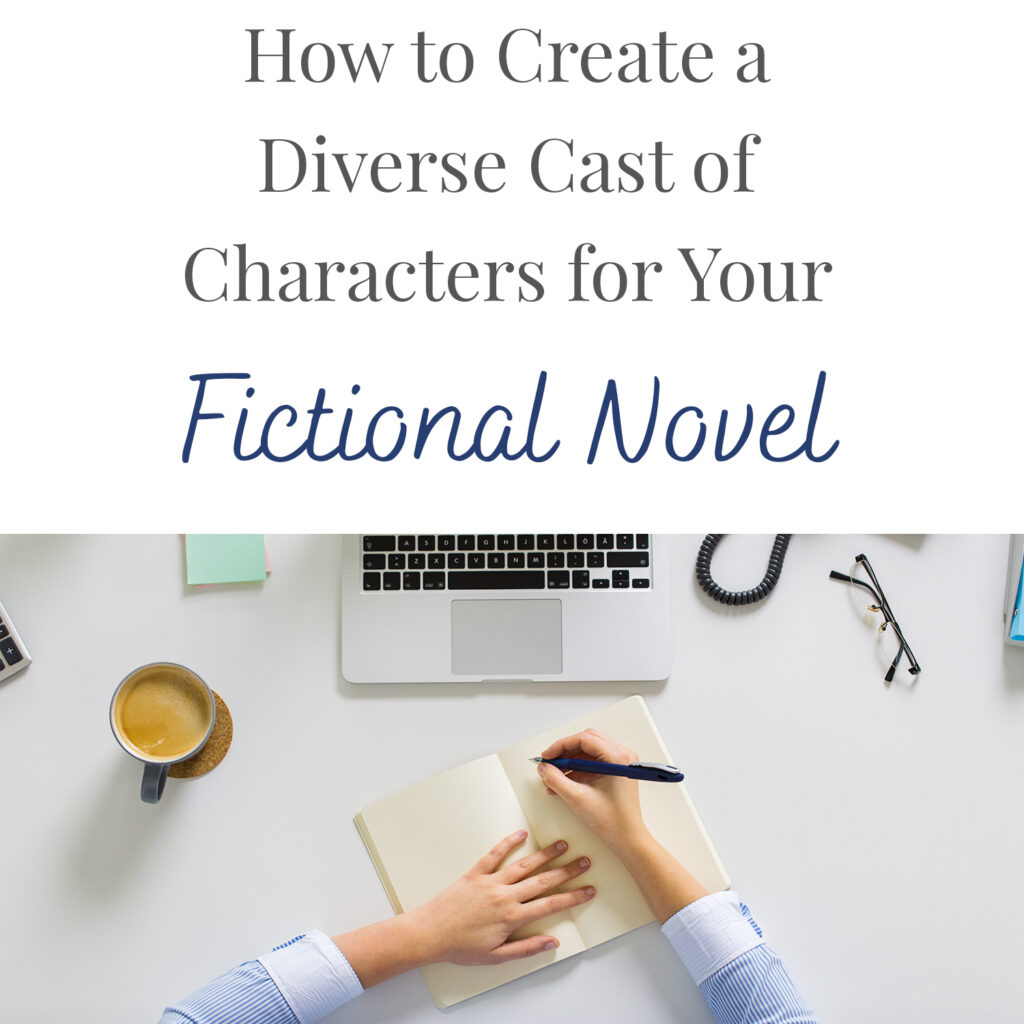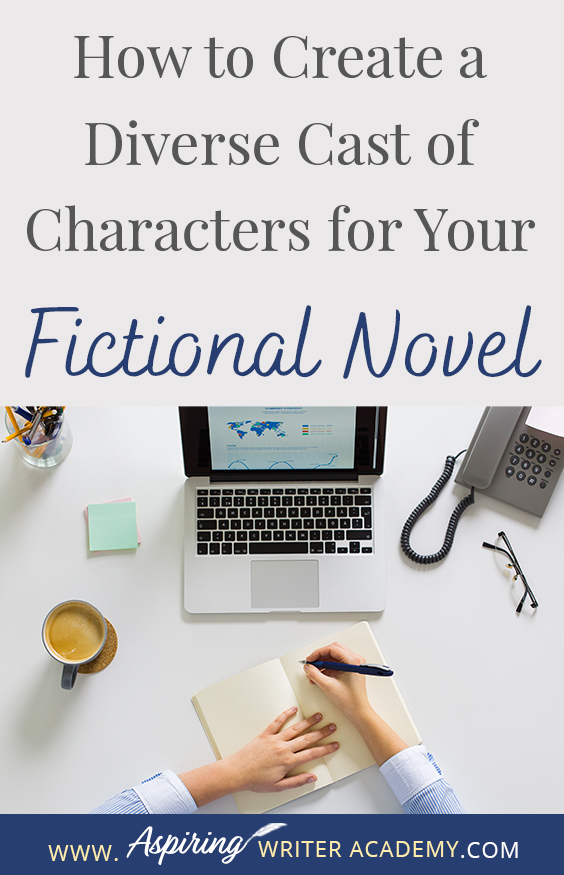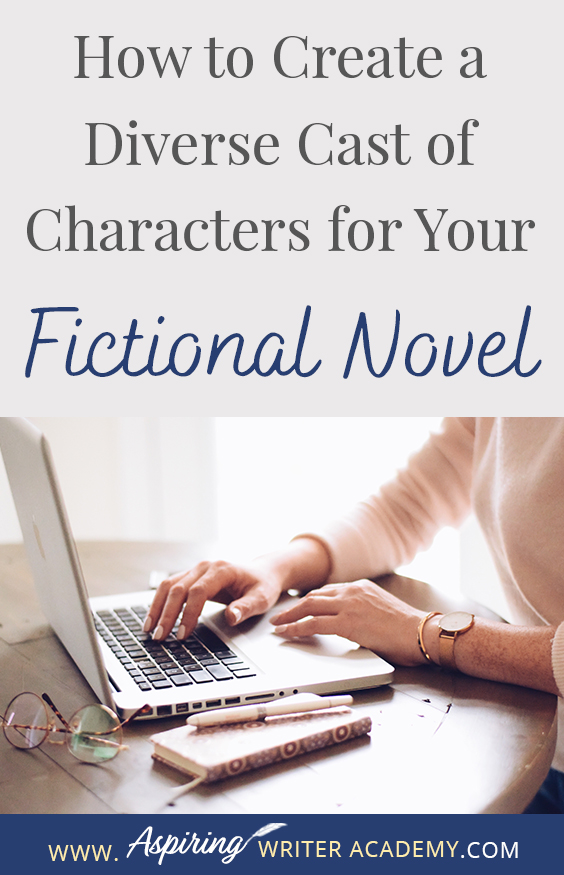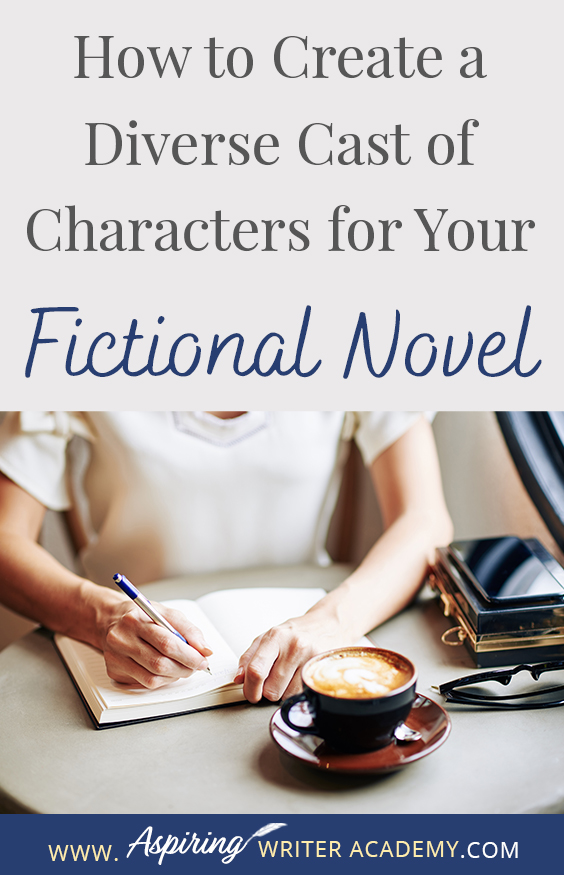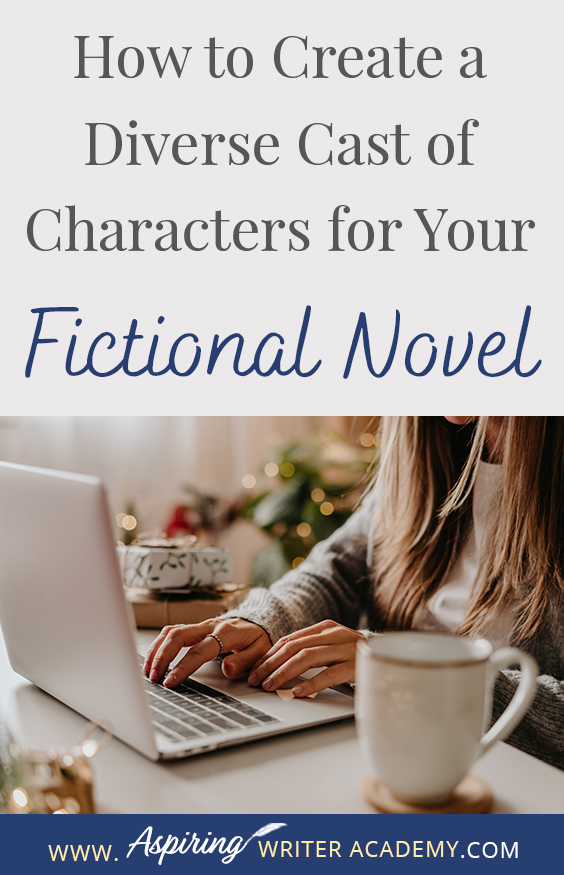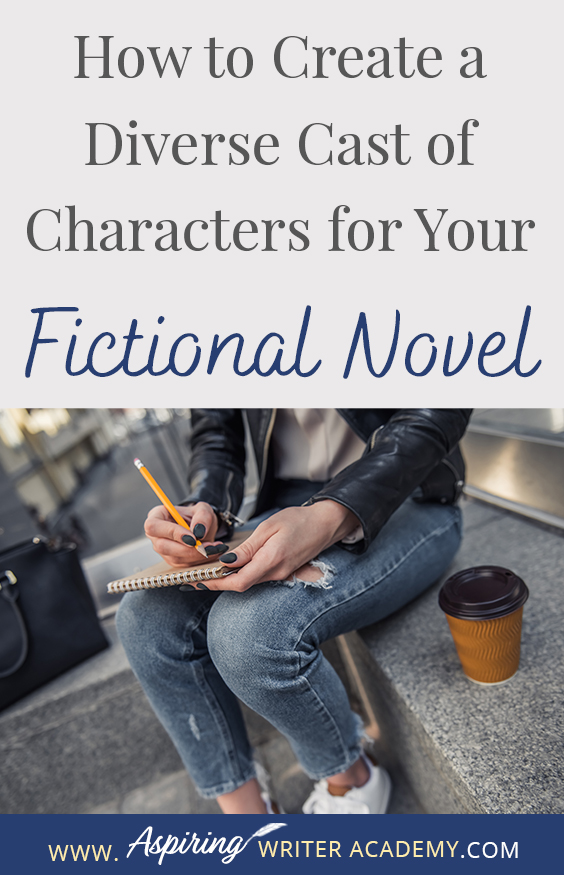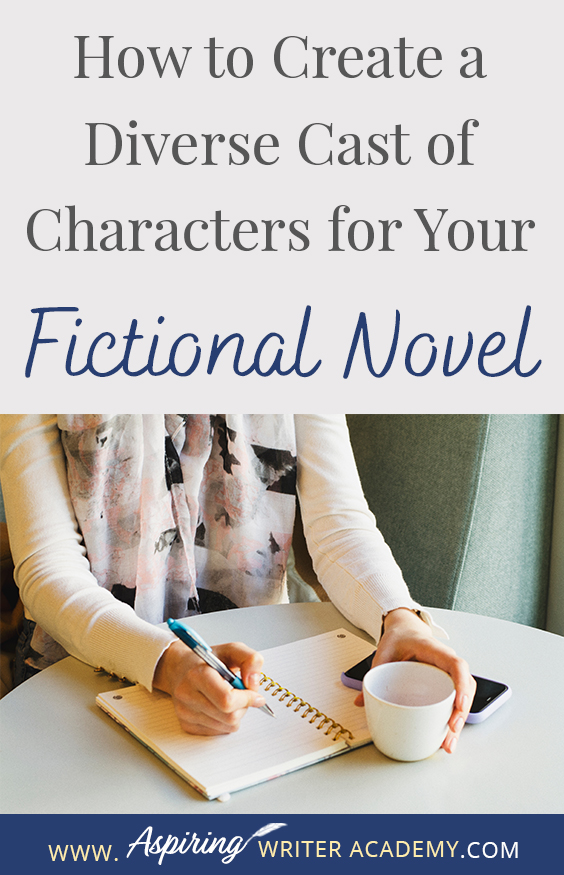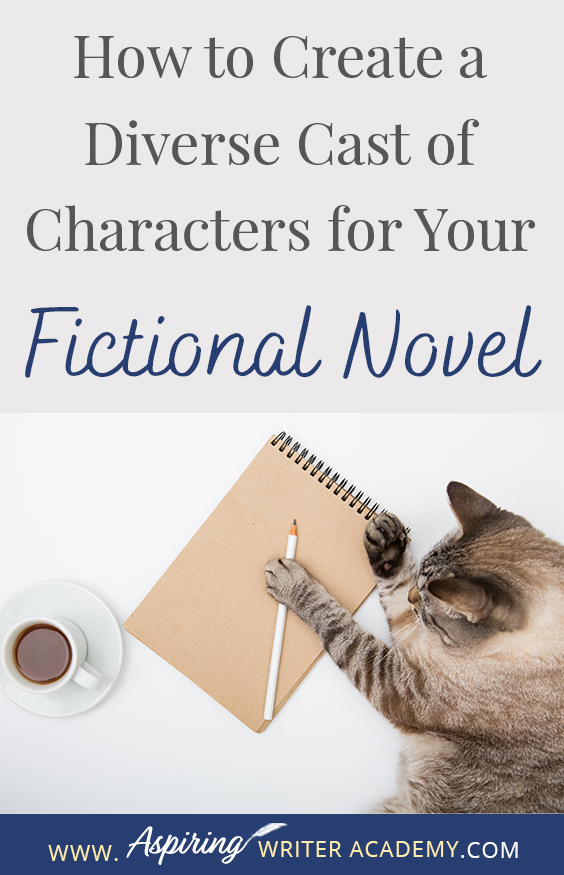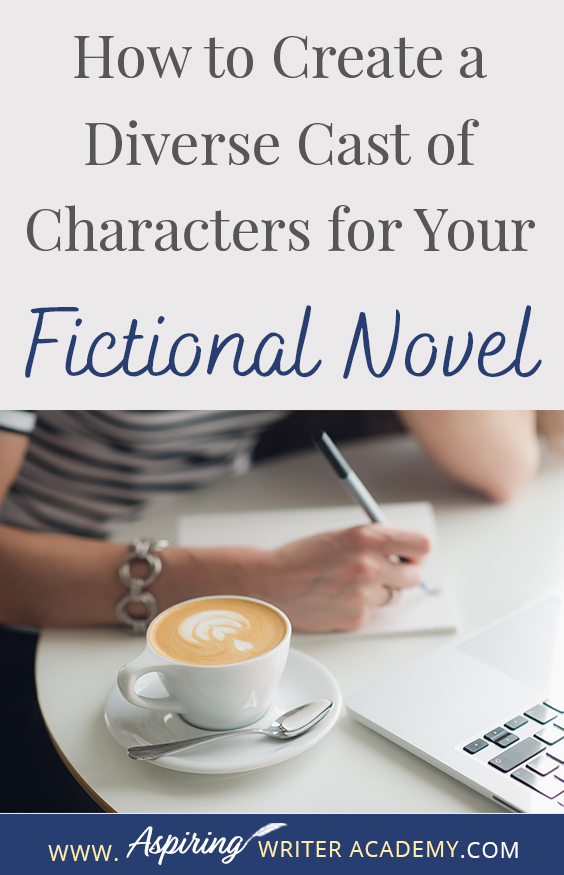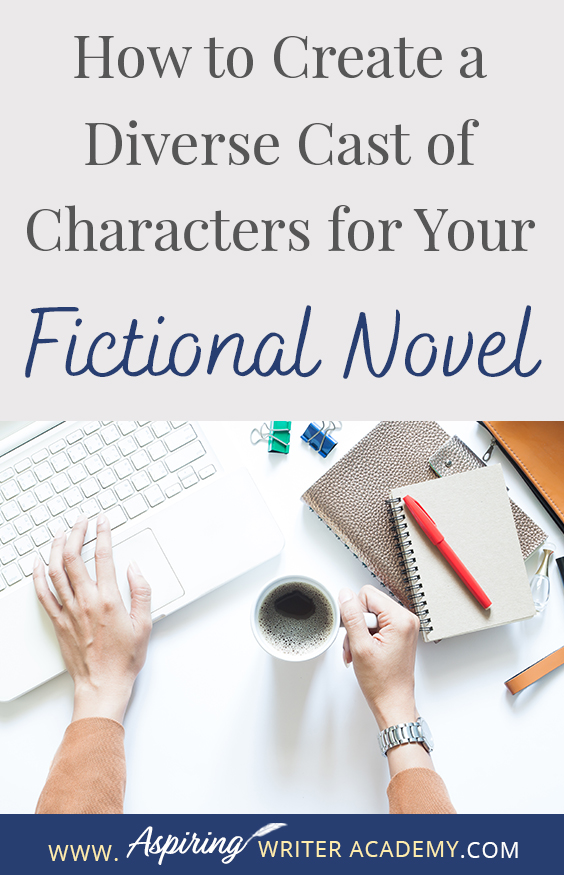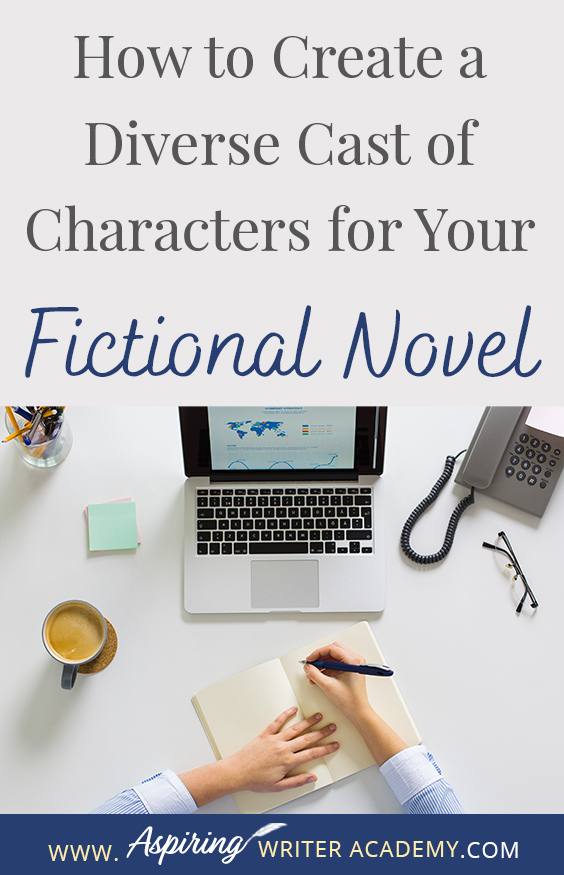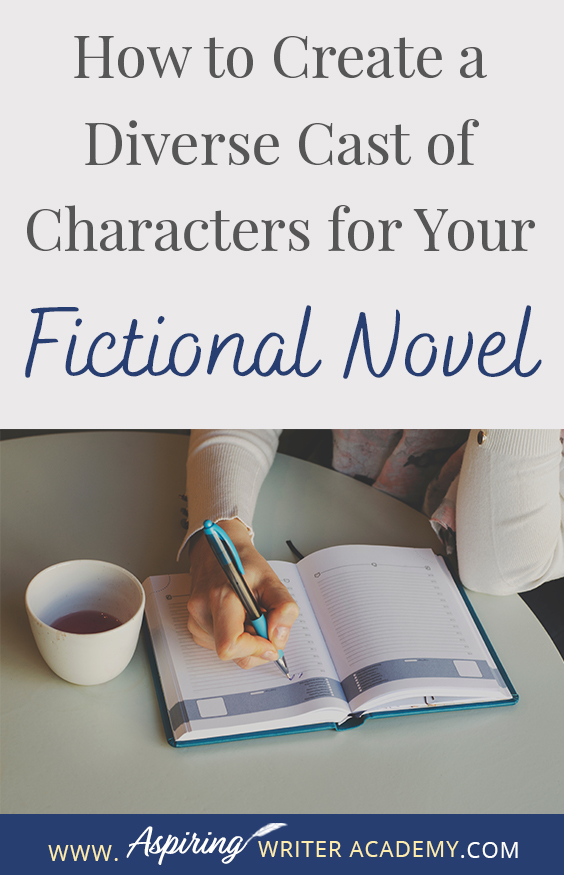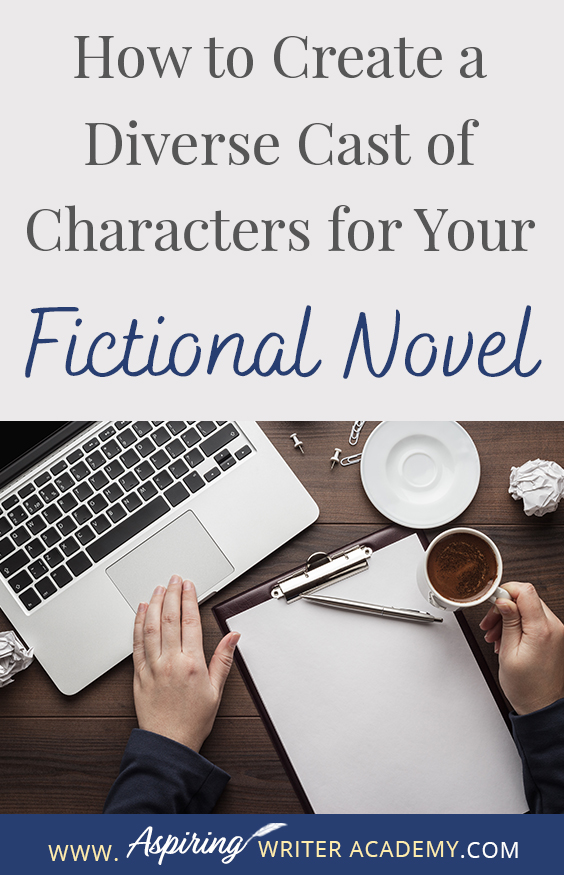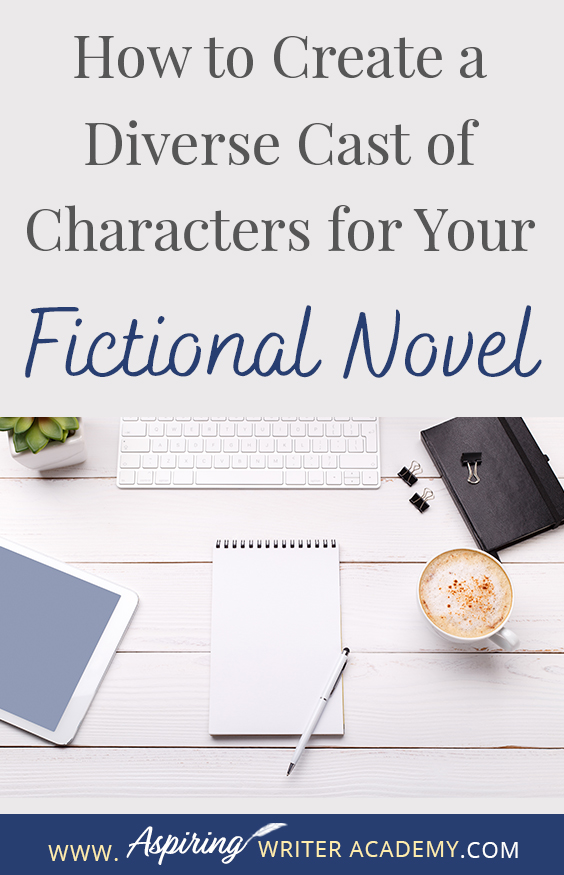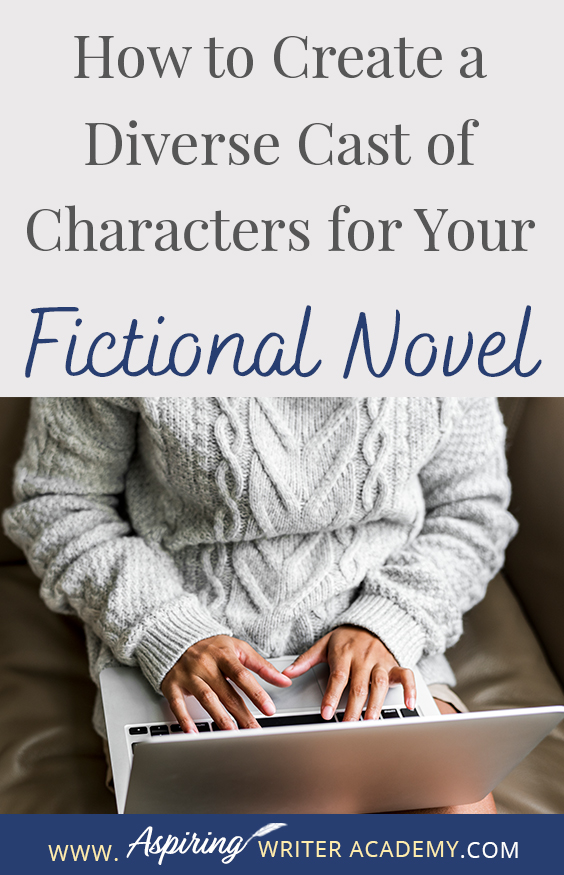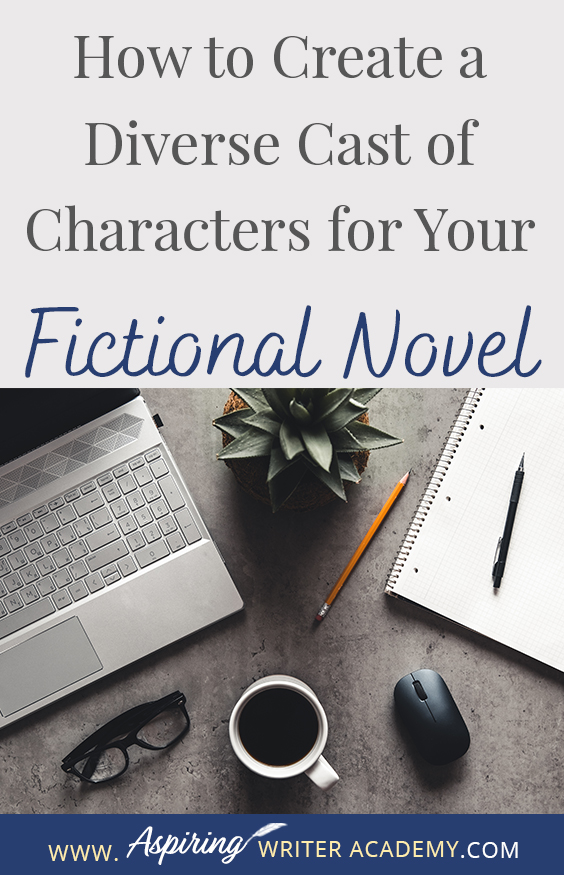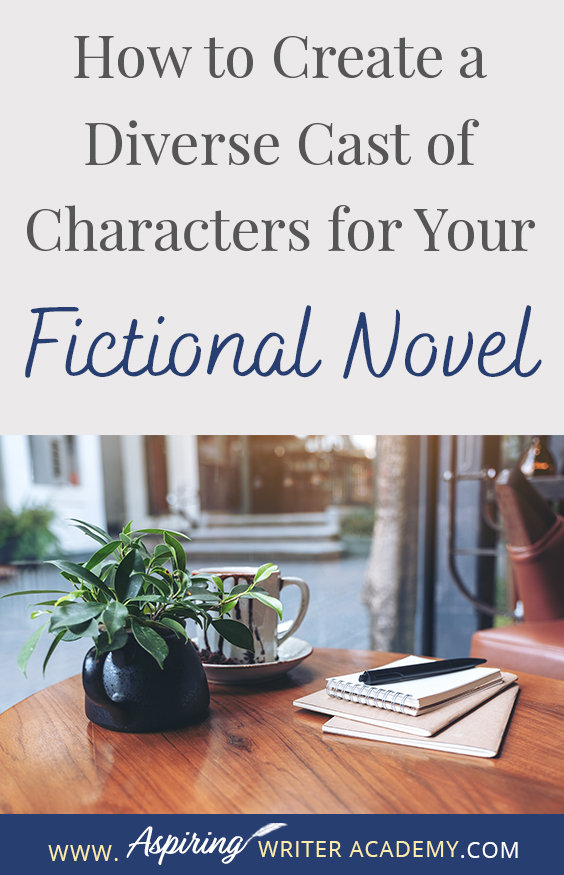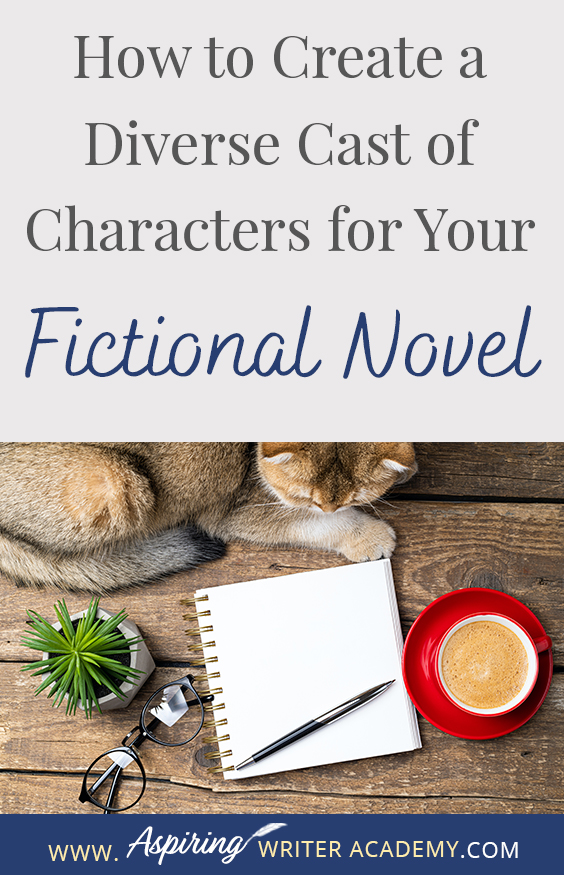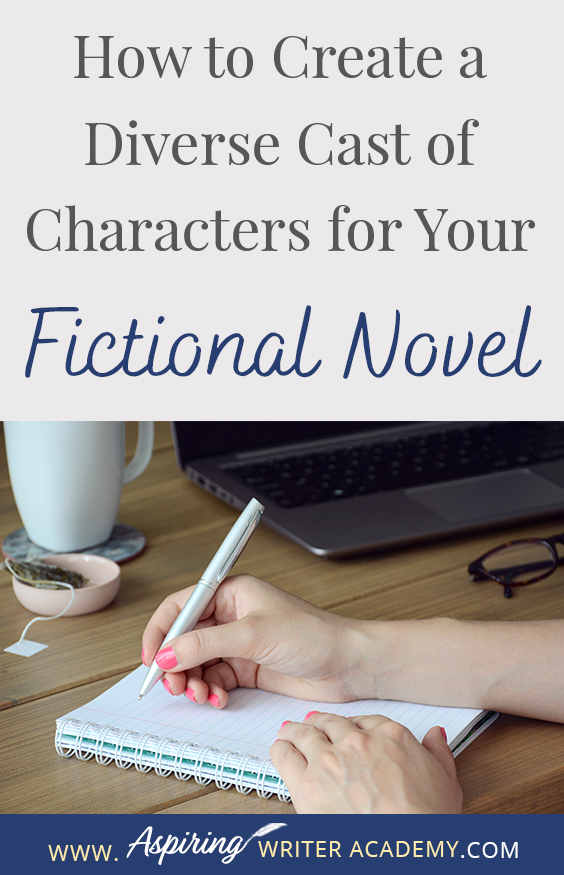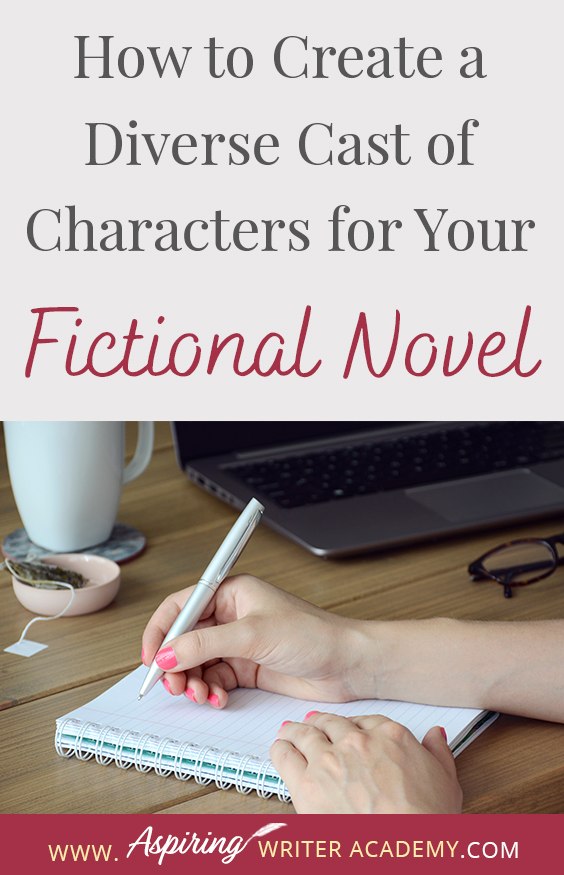How to Create a Diverse Cast of Characters for Your Fictional Novel
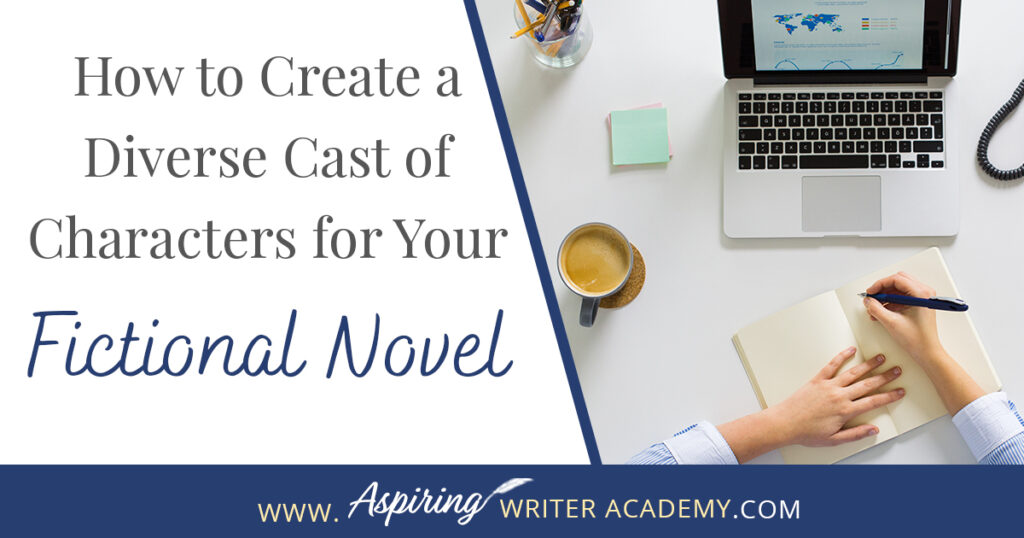
Have you read a book where all the characters sound the same and you have trouble remembering who is who? Without dialogue tags, would you know which fictional character is speaking? How can an author create characters that are unique?
In our post, How to Create a Diverse Cast of Characters for Your Fictional Novel, we show you how to intentionally design characters who contrast with one another in various ways to create additional conflict and raise the tension in the plot.
In the post below we will discuss:
- Physical Differences
- Personality Contrasts
- Opposing Viewpoints
Diversity is a popular topic these days and book publishers and Hollywood movie producers all want stories with a wide range of different characters to reach a wider audience. They want a large majority of their readers / viewers to feel included as they connect with different characters.
Movies such as: Guardians of Galaxy, The Lord of the Rings, The Hobbit, Armageddon, Pride & Prejudice, Avatar, Titanic, Jurassic Park, Harry Potter, Sweet Home Alabama, all have diversified casts where each character is different from one another in their appearance, personality, and viewpoints. Even in the new Barbie movie – with so many different Barbie’s and Ken’s: while they may share the same name, not two characters are alike.
In each of these popular movies, all the main characters and sub-characters are all different from one another. When characters are unique, they stand out in the reader’s mind. They can be easily identified when speaking, making it easy to eliminate many of the ‘he said’ – ‘she said’ dialogue tags.
Characters who contrast with one another also increase the potential for arguments, fights, those seeking revenge, and create all sorts of tension-filled drama. And at the heart of a good story is conflict. This is what keeps readers turning pages!
However, creating a diversified cast can seem daunting. How is it done?
First, take a look at where your story is set and make a list of all the typical characters you would expect to find in a place like this. Perhaps they have different professions or if they all work in the same place, look at their individual roles. (Think about the hit TV series, “The Office.”) Or maybe the characters in your story will all have different roles in the community or in an organization or within a family. Who would you not expect to be here?
Look at each character individually and as we discuss physical differences, personality contrasts, and opposing viewpoints, ask yourself — who would be this character’s opposite?
1) Physical Differences
You can make your characters distinct by contrasting their physical differences. Start with your main character and ask —who is this character’s opposite? Or who is similar, but different. Then you must follow that question up with — different how? Is it enough to cause conflict? Continue to the other characters in your cast and ask the same questions for each one, even your sub-characters.
In the 1988 movie “Twins” starring Danny DeVito and Arnold Schwarzenegger the humor is that the two brothers couldn’t look more different. Supposedly one embryo received more positive traits than the other. One of the twins is tall and muscular, while the other is short and round. The differences also continue with their personalities and viewpoints, which we will talk about later.
How do you create a diverse cast of characters?
As you create a cast for your fictional novel consider their goals, motivation, occupation, personality, background, family history, culture, gender, age, body type, hair and eye color, and speech patterns to make each one different from one another.
Does one character have body piercings or scars while another has had plastic surgery or wears heavy makeup? Does another character use a cane or walk with a limp? Do any of your characters wear glasses? Do any characters need hearing aids?
A character who is physically weaker than others may not be able to do the job expected of him. If others are depending on this character, then there could be conflict. Tension will rise if the character who still suffers from an old knee injury cannot outrun the bad guys and gets caught. His mission or the mission of his team could be compromised if he is forced to talk.
The cast of “The Lord of the Rings” based on the book series written by J.R. Tolkien, consisted of small childlike looking hobbits, pristine elves, hairy bearded dwarves, tall wizards, monstrous-looking orcs and many other different beings, all different from one another in appearance. Each one also had a different style of dress and accessories to go with that style of dress (swords, axes, staffs, jewelry, cloaks, headbands, leather shoulder bags).
What accessories might each of your characters possess to signify who they are and how they are different from one another?
What would each of the characters in your cast be expected to wear? How can you surprise the reader by having your character dress differently? What is the motivation for why this character dresses differently than expected? What is the backstory?
While thinking about their different professions and personalities, also consider how they might smell. Think about perfumes, after shave, cologne, saddle leather, lavender soap, hospital antiseptic, gasoline, grease, gunpowder, or sweat.
It is possible that conflict might arise if a guy who smells like a pig or who stepped in cow manure shows up at the door of his sweet, floral scented girlfriend’s house to take her on a date. How would she react? How would her parents react?
Create a chart.
Make a spreadsheet, graph, or chart listing each character’s name, and their physical attributes so that you can clearly see which character may clash or come into serious conflict with another character due to their differences. Leave extra spaces to also fill in differences in personalities and viewpoints.
Looking at the chart, how can you make each character in the cast contrast with each other even more? Who represents the opposite of each character?
2) Personality Contrasts
In the TV series, “The Odd Couple” much of the humor and conflict came from the fact that one character was a neat freak and the other a slob, yet they still had to find a way to live with one another.
Personality and appearance are created together, because a person’s personality usually dictates how he or she will dress, style their hair, appear to the public and live their life.
How does who they are affect how they dress?
While one character may be known for wearing Hawaiian shirts, another may be famous for his black leather motorcycle jacket. Another character may love the 1960’s style dress or wear a cowboy hat.
(Although conflict may arise for a cowgirl who is fashionably dressed all in pink (like in the 2023 “Barbie” movie) if she tries to rodeo with a true grit cowgirl wearing denim and dusty chaps. At first glance, what will they each think of one another?)
Why does this character dress this way? Much of their motivation comes from their backstory, which helped shape their personality today.
Is your female character all glitz and glamor with dresses featuring stomach cut-outs to show off how sexy she is – eager to seek attention?
Or does she dress in flannel shirts and overalls to fit in with the other guys on the job?
Or does she strip off the stiff business suit she is forced to wear during the day at work to don a more comfortable tank top with a pair of sweats or leggings at home? What does this say about this character, other than she prefers comfy clothes? Is she happy with her job or does she wish for a different kind of employment?
Preferred Food: What would each character, with their own unique personality, choose to eat at a restaurant?
Shelter: What kind of house or dwelling would they live in? Does a character live on a houseboat, cabin, or in a cave?
Transportation: how do each of your fictional characters get to work or go around town? Do they drive, walk, fly, roller skate, ride a horse, or take a taxi, ferry, bus, or a train?
Speech: Does one character have a southern drawl or a melodious Irish accent? Do any of your characters use ethnic slang? Do any characters have a lisp when they speak or stutter or cough when nervous? Does one have a pet phrase or keyword that is often repeated? Or does a character hesitate or have broken speech patterns?
Habits and Quirks: Do your characters twiddle their thumbs, bite their nails, run their hands through their hair, chew with their mouth open, or release nervous giggles?
Does a character stoop to pick coins up from the pavement of a parking lot only to donate them to the poor?
Does someone continue to wear a cherished coat even though there are a few holes in the ragged hem and refuse to buy a new one?
Continue to chart the differences in your fictional characters.
Look at how their personalities differ from one another with both positive and negative traits. Each character should have their own unique backstory and motivation for doing the things they do. How can these personality differences get them into trouble with one another? What kinds of conflict can these differences cause in your fictional novel?
3) Opposing Viewpoints
Each character in your fictional novel may have a different opinion on how something should be done. This makes for great conflict. How will the problem be resolved?
How do these opposing viewpoints tie back in to each character’s personality and their background histories? Why do they think the way they do? Was a character influenced by someone else when he or she was younger? Did a grandparent or a mentor instill these beliefs in your character?
Is each character’s viewpoint valid? Why do the two characters refuse to compromise to reach a resolution? What are the stakes? What are the consequences if they do not get their own way?
While drafting the scenes of your book, consider contrasting characters with different moral, social, economic, political, and cultural differences and set of beliefs.
If one character thinks one thing — who will think the opposite?
Don’t just use this for your main characters, but for your sub-characters also. What differences of opinion can lead your background characters to squabble with one another in the background? Can these squabbles tie into the main conflict facing the main character of the story?
In many fictional novels, there is no villain. The antagonist is simply another person opposing the protagonist (main character) because they have a different viewpoint on a particular subject or situation.
Example: A young man may want to marry the girl of his dreams, but she may only think of him as a friend and prefer to stay single. This causes conflict as the young man tries to change the girl’s opinion. (Okay, Spoiler Alert: I just saw the new 2023 “Barbie” movie, so my mind keeps traveling to the heartbreaking scene where the lovestruck hero mourns the fact that he is “just Ken.”
Each major character should have at least one personal goal or objective. How are their goals and motivation for pursuing that goal different?
How does this cause conflict?
An entire team may have the same goal, but if two or more characters have a different viewpoint on how the goal should be attained, there will be conflict. How can they resolve their conflict with one another so the goal may be achieved?
Cross-check your character cast chart and add in their differences of opinion or viewpoint.
Are the differences enough to cause conflict?
A varied cast makes both the characters and the story memorable.
We hope you have enjoyed How to Create a Diverse Cast of Characters for Your Fictional Novel and that you have gained some valuable tips to create unique characters with different looks, personalities, and viewpoints so your next fiction novel sticks in the hearts and minds of readers long after they finish reading the last page.
If you have any questions or would like to leave a comment below, we would love to hear from you!
If you like more help developing your story, you may wish to download our Free Brainstorming Your Story Idea Worksheet
Do you find it difficult to create compelling antagonists and villains for your stories? Do your villains feel cartoonish and unbelievable? Do they lack motivation or a specific game plan? Discover the secrets to crafting villains that will stick with your readers long after they finish your story, with our How to Create Antagonists & Villains Workbook.
This 32-page instructional workbook is packed with valuable fill-in-the-blank templates and practical advice to help you create memorable and effective antagonists and villains. Whether you're a seasoned writer or just starting out, this workbook will take your writing to the next level.
Our Goal for Aspiring Writer Academy is to help people learn how to write quality fiction, teach them to publish and promote their work, and to give them the necessary tools to pursue a writing career.

ENTER YOUR EMAIL BELOW
TO GET YOUR FREE
"Brainstorming Your Story Idea Worksheet"
7 easy fill-in-the-blank pages,
+ 2 bonus pages filled with additional story examples.
A valuable tool to develop story plots again and again.
Other Blog Posts You May Like
Write Your First Novel: How Do You Start?
Fiction Writing: What is a Character Arc?
How to Create Antagonists Who Are Not Villains
How to Create the Protagonist for Your Fictional Story
How to Choose Characters to Populate Your Fictional Story
Fiction Writing: How to Plot a Story where the Antagonist is an ‘Invisible Foe’
Creative Writing: 5 Ways to Strengthen a Weak Fictional Character
Fiction Writing: How to Write Compelling Dialogue

is a multi-published author, speaker, and writing coach. She writes sweet contemporary, inspirational, and historical romance and loves teaching aspiring writers how to write quality fiction. Read her inspiring story of how she published her first book and launched a successful writing career.

